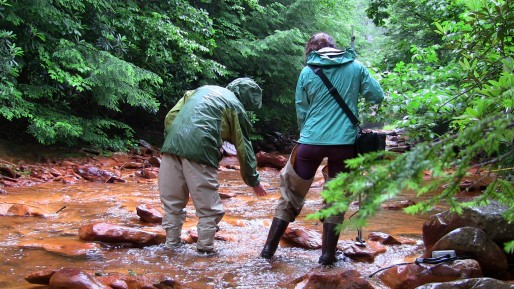West Virginia University is one of the 2015-16 winners of the Challenge Fund for Innovation in Journalism Education. See all 11 winners and the Honorable Mentions.
Partners
Team
- Emily Corio, Teaching Assistant Professor, West Virginia University Reed College of Media, @ecorio1
- Dana Coester, Assistant Professor, Creative Director Reed College of Media Innovation Center, @poetabook
- Other faculty from across the College of Media
- Nicolas Zegre, PhD, WVU Assistant Professor of Forest Hydrology; Chair-Water Resources Working Group, Society of American Foresters
- Todd Petty, WVU Professor of Forestry and Natural Resources, @jtoddpetty
- Fergus Pitt, Fellow, Tow Center for Digital Journalism, Columbia University, @fergle
- John Keefe, Senior Editor, Data News Team, WNYC Radio, @jkeefe
- Suzanne Moore, Executive Director, Friends of Decker’s Creek, @FODC_WV
- Ken Ward, Reporter at the Charleston Gazette, @Kenwardjr
- David Mistich, Digital Editor/Coordinator at West Virginia Public Broadcasting, @davemistich
Describe your project as a tweet
StreamLab: Exploring a model for beacon-triggered, sensor journalism as participatory public affairs reporting in WV’s community waterways.
What are you going to test?
West Virginians have long lived in the shadow of contaminated waterways running through their communities and their own backyards. This community reporting project will test new practices in journalistic storytelling using collaboratively sourced water-quality data, collected via sensors with interaction triggered by beacons. We will test beacons as a reporting tool and as a storytelling, interface and distribution tool in order to:
- Experiment with new practice combining beacon and sensor technology for students, faculty and media participants, and
- Increase community engagement with local environmental and public affairs issues in a location-based, real-time, participatory process.
How will the experiment be conducted?
Sensors will be placed in public waterways where community members will connect to the project via a beacon network that triggers a mobile application. Passersby can access sensor readings of real-time water quality parameters, and will be prompted to enter sensor readings into a mobile app, along with personal observations as additional qualitative data. Because we are working with real-time data and dynamic observations, this experiment will explore new storytelling practice with beacons as a location-based, streaming documentary form.
A special topics class will house the project with journalism, interactive design, computer science and forestry students, led by a faculty team that includes WVU water researchers. In addition to hands-on experimentation with beacons and sensors, students will conduct field reporting on sources of pollution, examine economic and regulatory issues, and illuminate possible inconsistencies between community-sourced data and official sources.
West Virginians realize their waterways are polluted from unplanned commercial development, acid mine drainage, and other byproducts of coal mining and extraction industries. This knowledge is coupled with a growing distrust of official data due to a lack of transparency in the state’s extraction economy and in response to the January 2014 Charleston, W.V., chemical spill last contaminated the water supply for 300,000 residents. This project will reveal whether a hands-on, transparent process of engaging with data can instill a transformative sense of ownership over the community’s data and ultimately the story it tells.

How will you know if it worked or not?
We will build and measure local, regional and national audiences for both the project and its stories. All participants will help narrate the project, and their findings will serve as a candid resource for other journalism programs, students and journalists. If a group or public body takes any action as a result of our findings and stories, this will be another concrete measure of the project’s impact. The degree to which curriculum is changed within our college and any adoption of new practice or models developed will also be an indicator of success.
How is this project unique and innovative?
Use of sensors and beacons are part of an emerging ecosystem — The Internet of Things (IoT), in which mobile devices, wearables, sensing devices and smart objects access and interact with ubiquitous, ambient data. Measuring and making sense of pervasive, location-specific, environmental data presents all-new challenges to computer scientists, journalists, media makers and civic agencies alike.
In the course of conducting this experiment, our faculty, students and community partners will learn new methods for reporting and conceiving story — from data acquisition through design and distribution — as a location-based, streaming, documentary form, which will help chart new territory in journalism practice.
Most importantly this project will provide practical tools, processes and training using relatively low-cost technology to West Virginia journalists and community members for original investigative reporting. Both the state’s news organizations and community agencies are taxed with addressing environmental issues of increasing critical importance to the state, yet both are under-resourced and often must rely on external official sources.
This project helps to transfer new skills to community media to better enable their watchdog function (which will be more important than ever as an over abundance of data continues to transform the public commons) as well as helps acclimate all participants to using DIY approaches to technology adoption and experimentation.
In addition, collaborating directly with community members in engaging with data as a civic reporting process will provide insights and potential models for new curriculum, new practice, as well as help community members become agents of local data.
What technology platforms will you use?
We are using low-cost, open-source solutions that can serve as ubiquitous mobile sensing devices (USDs). These tools include Arduino microcontrollers — multi-parameter sensor units that use solar power to detect water quality variables, such as temperature, acidity, alkalinity, electrical conductivity, dissolved oxygen, turbidity, and nitrogen — and low-cost proximity beacons for creating a network that defines the community’s waterways. The beacon network will prompt data input at the outset of the project, as well as enable users to interact with the story in atomized form as a location-based narrative. We will build a mobile app for entering and sharing the data, that uses open-source code, such as proximitykit, as well as experimenting with Qualcomm Vuforia and Metaio, which are augmented reality software development platforms that can provide AR and location-based features in the mobile app.
How might this experiment change teaching at your school or media practices in your partner’s newsroom?
This project builds upon the momentum within our College to experiment with new technology in reporting and publication processes and provides additional lessons learned, tools and templates for use in the classroom and in the newsrooms of our media partners. This experiment, as with others we have conducted, will result in adoption of new curriculum, both within established courses, but also informing the creation of new classes, as well as informing an innovation-focused Masters In Media Solutions program we are currently developing. Our program has long worked throughout the state with many West Virginia media outlets. This model helps to advance the relationship between our students, faculty and local media as ongoing collaborators in real-world experiments and problem solving. We will work with media participants after the project to help diffuse the skills, insights and results acquired through this project in their own newsrooms and professional networks.

What could go wrong?
Since we want the data to lead our students reporting, one potential problem is that we could become overwhelmed with story approaches. One way to avoid this is to fully utilize our expert environmental reporter, Ken Ward, and our water researchers, Nicolas Zegre and Todd Petty, to provide context around water quality issues in Morgantown and the state in general so that our students’ stories focus on the most pressing issues. Community engagement may be insufficient, and if so, we will address that early on and with persistence.
We assume everything that can, will go wrong, especially when experimenting with unfamiliar technologies and across different skill sets. We recognize that collaborative trouble shooting our way through those challenges is one of the key lessons for our students. We have minimized risks by assembling an enthusiastic team with experience working in innovation models; by working with low-cost open source tools and software; by working with technologists we have worked with in the past; and by drawing upon other expertise in the University and leveraging strong relationships with university technologists and faculty in computer science, interactive media. We accept that setbacks are an inherent part of experimentation, and make clear that a worthy goal is to instill improvisational skills in hacking technology and new processes. Sharing risks in this manner requires trust, and we will maintain consistent and transparent communication with all of our partners throughout the process so we can evaluate, adapt and improve our experiment as we move forward.

